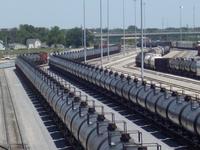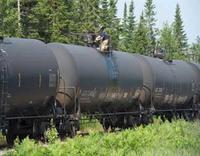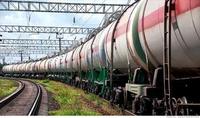-
Seattle builds resiliency in the face of changing climate
The federal government’s National Climate Assessment, released in May, detailed the region-by-region effects which includes water shortages, sea-level rise, and more frequent wildfires. Most American cities fall short on climate change preparation when compared to several major cities around the world. A survey conducted by MIT reported that globally, “the U.S. has the lowest percentage of cities engaged in (climate change) assessments and planning.” Seattle has decided it needs to act, and act now, to make itself more resilient in the face of a changing climate.
-
-
Iowa to allow public release of information about trains carrying crude
Iowa officials have announced that they will alert the public about trains carrying one million gallons or more of “extra-flammable” crude oil throughout the state — despite the argument of railroad companies that the information could pose a security threat. Iowa’s decision places the state in the spotlight as a possible model for how the rulings will proceed in the rest of the country.
-
-
U.S. Northwest prepares for the Big One
Seismologists believe the Pacific Northwest is overdue for an earthquake that could register at over 8.0 on the Richter scale, leading many emergency management professionals in the region to anticipate and prepare for the devastating impact such an event would have on the local economy. Experts talk about Triple 3 Resilience Target as a the goal for managing the aftermath of an earthquake: have emergency services running within three days; level of services to sustain the economy within three weeks; and a target of three years to stabilize the economy and prepare for future disasters.
-
-
Experts urge deployment of earthquake warning system in California
Scientists say that California has “99.7 percent chance of experiencing a severe earthquake — magnitude 6.7 or higher on the Richter scale — within the next 30 years.” These scientists are urging Congress to consider funding the full-scale deployment of an early-warning earthquake system on the western coast of the United States following successful testing of a prototype and positive results from similar international systems.
-
-
New app helps kids in tornado-prone areas understand disasters
Kids growing up in tornado alley are used to bright, splotchy radar patterns moving across a television screen, and most know the difference between a tornado watch and warning. Do they understand, however, how to read and predict the weather based on radar images and forecasts? Researchers hope to remove the mystery around weather forecasting by speaking to kids in a language they could better understand — gaming.
-
-
Feds, rail operators, Washington State embroiled in crude oil shipment disclosure dispute

Last month the U.S. Department of Transportation(DOT) ordered rail carriers with trains carrying crude oil to notify state officials in the states through which the trains pass about the volume, schedule, and routes of these trains. The amount of crude oil transported by trains has grown dramatically – from 6,000 carloads in 2005 to more than 400,000 carloads in 2013. The increase in the volume of crude oil shipping has been accompanied by a sharp rise in the number of accidents and derailments. DOT’s order was meant to allow states’ first responders to be prepared, but the railways treat shipping information as “security sensitive” and refuse to share it with states’ officials unless the information is distributed to emergency response groups for planning purposes only. Washington State says that state laws require that such information be made public.
-
-
All-natural mixture offers promising fire retardant
What sounds like fixings for a wizard’s potion — a dash of clay, a dab of fiber from crab shells, and a dollop of DNA— actually are the ingredients of promising green fire retardants invented by NIST researchers. Applied to polyurethane foam, the bio-based coatings greatly reduced the flammability of the common furniture padding after it was exposed to an open flame. Peak and average rates of heat release — two key indicators of the magnitude of a fire hazard — were reduced by 48 percent and 77 percent.
-
-
Rio builds a high tech integrated urban command center

Rio de Janeiro is one of the most densely populated cities in South America. Much of the city is vulnerable to flooding, and about three-quarters of Rio’s districts have areas at risk of landslides. High temperatures can make living situations unbearable. In addition, a high crime rate and poor infrastructure make the city difficult to govern. In preparation for the 2014 World Cup and 2016 Summer Olympics, authorities are looking to improve response times to disasters and establish a more efficient system to deal with the city’s many challenges. One of the solutions is a high tech integrated urban command center — Centro de Operações Preifetura do Rio de Janeiro (COR) – which unites Rio’s thirty departments and some private suppliers in a single monitoring room where operators can track real-time conditions of the city and coordinate a response to emergencies and disruptions.
-
-
Canada is not doing enough to prepare for, cope with natural, man-made disasters
The 2013 Alberta floods cost more than $6 billion, making it the worst weather disaster in Canada’s history. Before 1990, only three Canadian disasters exceeded $500 million, but in the past ten years alone nine disasters have exceeded that amount. Disaster management experts said that while it may be understandable that corporate and municipal budgets for disaster training and preparations have been reduced during the economic slowdown, corporate and government leaders in Canada must consider how such reductions would impact the ability of communities to build adequately resilience systems against potential natural and manmade disasters.
-
-
U.S. to require railroads to notify states when oil is shipped

With the increase in available oil from fracking and larger pipeline capacity, railways are moving more and more oil. Rail companies moved 400,000 oil carloads in 2013, dwarfing 2005’s 6,000 oil carloads. The increase in oil shipments of oil has led to an increase in the number of accidents involving oil tankers. In the wake of recent accidents, the U.S. Department of Transportation (DOT) has released an emergency order to railroad companies which is designed to reduce the risk when shipping crude oil across the nation.
-
-
More crude oil shipments by rail mean more accidents, but security measures lag

American rail companies have long operated under federal laws, making it difficult for local officials to gather information on cargo and how rail companies select their routes. An increase in the number of trains transporting crude oil, accompanied by a series of derailments and explosions, has highlighted the dangers of transporting hazardous substances by rail.In February, the Department of Transportation announced that railroads had voluntarily agreed to apply the same routing rules to oil trains that they currently apply to other hazardous materials. Critics say more needs to be done.
-
-
Small Virginia town debates cost of emergency siren system
Installing an emergency siren system in Danville, Virginia would be too expensive, Danville fire chief David Eagle said during a recent update to the Danville city council on emergency notification systems. The city’s last siren system was discontinued about twenty-five years ago. A new system would cost between $300,000 and $400,000 to install, and would incur annual maintenance cost.
-
-
HHS proposes rules to govern health-care facilities’ disaster preparedness
The Centers for Medicare and Medicaid Services(CMS), a federal agency within the Department of Health and Human Services, has proposed new requirementsfor health-care facilities intended to ensure these facilities are prepared to care for patients during disasters. The regulations aim to prevent the service disruptions which occurred during Hurricane Sandy and Hurricane Katrina, when an estimated 215 deaths occurred in hospitals and nursing homes in Louisiana.
-
-
NIST launches effort to improve disaster resilience of communities
The National Institute of Standards and Technology (NIST) will host the first of six workshops devoted to developing a comprehensive, community-based disaster resilience framework, a national initiative carried out under the President’s Climate Action Plan. The workshop will be held on Monday, 7 April 2014.
-
-
Studying the 2011 Mississippi and Ohio rivers flood for better flood preparedness
In May 2011, when the U.S. Army Corps of Engineers used explosives to breach a levee south of Cairo, Illinois, diverting the rising waters of the Mississippi and Ohio rivers to prevent flooding in the town, about 130,000 acres of Missouri farmland were inundated. It was the largest flood of the lower Mississippi ever recorded. Researchers took advantage of this “once-in-a-scientific-lifetime” occurrence to study the damage in order to demonstrate that landscape vulnerabilities can be mapped ahead of time to help communities prepare for extreme flooding.
-
- All
- Regional
- Water
- Biometrics
- Borders/Immig
- Business
- Cybersecurity
- Detection
- Disasters
- Government
- Infrastructure
- International
- Public health
- Public Safety
- Communication interoperabillity
- Emergency services
- Emergency medical services
- Fire
- First response
- IEDs
- Law Enforcement
- Law Enforcement Technology
- Military technology
- Nonlethal weapons
- Nuclear weapons
- Personal protection equipment
- Police
- Notification /alert systems
- Situational awareness
- Weapons systems
- Sci-Tech
- Sector Reports
- Surveillance
- Transportation
Advertising & Marketing: advertise@newswirepubs.com
Editorial: editor@newswirepubs.com
General: info@newswirepubs.com
2010-2011 © News Wire Publications, LLC News Wire Publications, LLC
220 Old Country Road | Suite 200 | Mineola | New York | 11501
Permissions and Policies
Editorial: editor@newswirepubs.com
General: info@newswirepubs.com
2010-2011 © News Wire Publications, LLC News Wire Publications, LLC
220 Old Country Road | Suite 200 | Mineola | New York | 11501
Permissions and Policies
